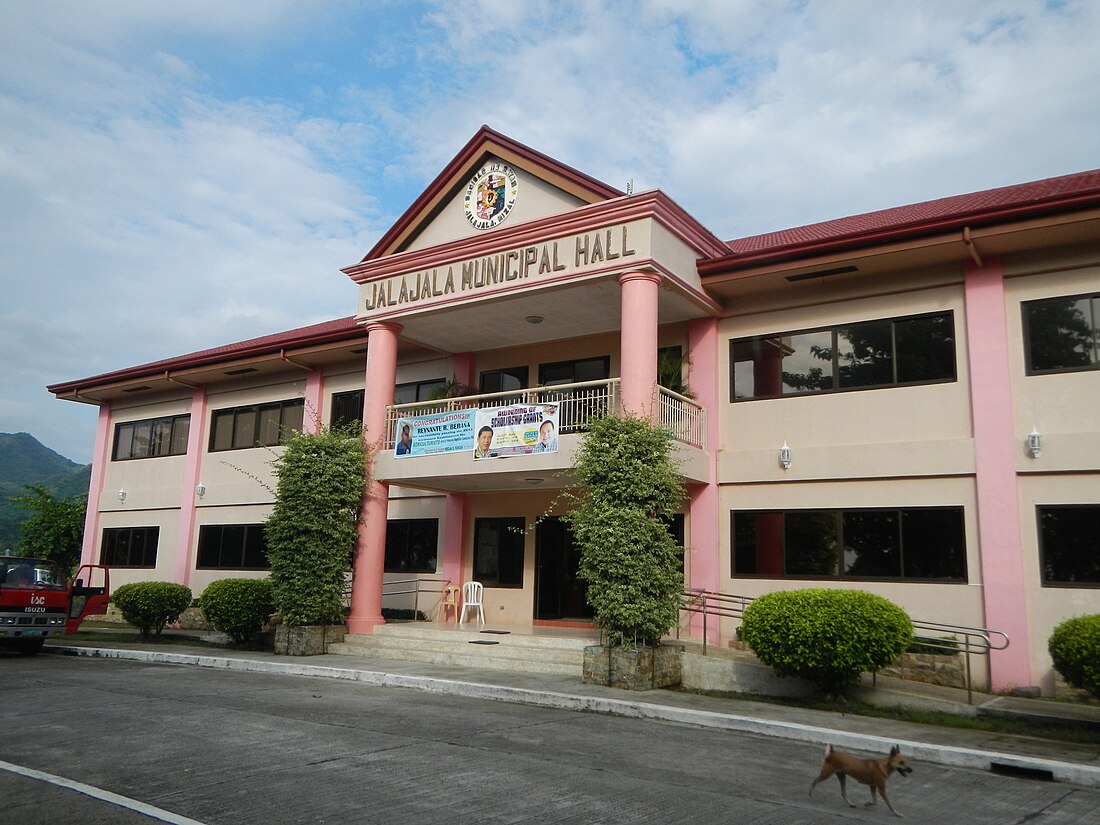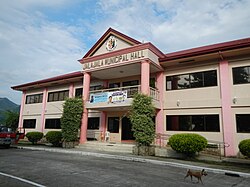Top Qs
Timeline
Chat
Perspective
Jalajala
Municipality in Rizal, Philippines From Wikipedia, the free encyclopedia
Remove ads
Jalajala (Tagalog pronunciation: [hälɐ̞ˈhalɐ (-ˈhala)]; also spelled as Jala-jala), officially the Municipality of Jalajala (Tagalog: Bayan ng Jalajala), is a municipality in the province of Rizal, Philippines. According to the 2024 census, it has a population of 34,901 people, making it the least populated municipality in the province.[5]
This article needs additional citations for verification. (October 2013) |
Remove ads
Etymology
What is now the town's Barangay Punta was the seat of an earlier settlement later known as Halaán. During the summer from April to May, the shores of Laguna de Bay along Punta would be filled with small shellfish locally known as halaán.
As is typical with many modern Philippine toponyms, the town's name supposedly resulted from miscommunication between early Spanish visitors and natives. The Spaniards enquired of some natives along the shoreline, "¿Como se llama este sitio?" ("What is the name of this place?") to which the latter replied, "halaán pò," thinking that the foreigners referred to the shells. The Spaniards accepted the response as the name of the place, and began calling it halaán, later corrupting it into Chimae then into Jalajala.
Another folk etymology is that Jalajala stems from an endemic breed of boar called berk jala, which is abundant in the wilds around the town and is depicted on its seal. As with the other story, a Spaniard asked the Tagalog-speaking natives the place's name, and the locals' interjection of "hala-hala” (possibly a hunting chant) was taken by the Spaniards to be their answer.
Remove ads
History
Summarize
Perspective
In 1610, it became part of Villa de Pila, an encomienda in La Laguna where locals were encouraged to raise livestock. On September 7, 1676, Jalajala was separated from Villa de Pila for civil and ecclesiastical administration. A bamboo church was built in 1678, followed by a stone church in 1733. The first map of Jalajala was drawn by Engineer Feliciano Marquez in 1767, titled “Islas de Jalajala.”
In 1786, Jalajala, initially a barrio, separated from Pililla to become an independent town, with the help of Don Julio Dollar. However, it was reverted to a barrio of Pililla in 1816. According to a Spanish historian, the development of Jalajala as a pueblo or town began as early as 1823.
The area became part of the Distrito delos Montes de San Mateo (later District of Morong) in 1853 and later Rizal in 1901. On October 12, 1903, it was returned to Pililla once again by virtue of Act No. 942.[6] Jalajala was re-established as a chartered municipality on March 27, 1907 by virtue of Act No. 1720.[7] Simeon Perez was elected as its first municipal president following the November 1907 election. It was auctioned in 1920 due to unpaid taxes, becoming the first Filipino-owned town.
From 1942 to 1945, during World War II, Jalajala was occupied by Japanese forces, and local guerrilla groups resisted occupation. The town was liberated in 1945. In 1979, the Japan International Cooperation Agency (JICA) supported infrastructure development, fostering growth in transportation, education, and agriculture.[8]
Remove ads
Geography
Summarize
Perspective

Jalajala is on a peninsula located 75 kilometers (47 mi) southeast of Manila in the largest freshwater lake in the Philippines, Laguna de Bay. It lies on the eastern part of the Rizal Province and has a land area of 4,930 hectares (12,200 acres) representing 3.77% of the total land area of the province. Jalajala's political boundary on the north is the Panguil River, wherein it shares the boundary with the town of Pakil in Laguna. On its southern, eastern, and western boundaries lies Laguna de Bay.
Mount Sembrano forms the boundary of Jalajala and Pililla.
Barangays

Jalajala is politically subdivided into 11 barangays (three urban, eight rural), as indicated in the matrix below and the image herein. [9] Each barangay consists of puroks and some have sitios.
- Bagumbong
- Bayugo
- Second District (Poblacion)
- Third District (Poblacion)
- Lubo
- Pagkalinawan
- Palaypalay
- Punta
- Sipsipin
- First (Special) District (Poblacion)
- Paalaman
Bayugo, Palay-Palay, and Sipsipin were elevated to barrios in 1956.[10]
Climate
Demographics
In the 2020 census, the population of Jala-jala, was 34,017 people,[17] with a density of 770 inhabitants per square kilometer or 2,000 inhabitants per square mile.
Remove ads
Economy

Poverty incidence of Jalajala
10
20
30
40
2000
37.72 2003
25.54 2006
14.90 2009
15.68 2012
19.73 2015
17.66 2018
12.40 2021
6.28 Source: Philippine Statistics Authority[18][19][20][21][22][23][24][25] |
Government
Summarize
Perspective
Local government
The municipality is governed by a municipal mayor designated as its local chief executive and by a municipal council as its legislative body in accordance with the Local Government Code. The mayor, vice mayor, and the councilors are elected directly by the people through an election which is being held every three years.
Elected officials
List of current government officials from June 30, 2022.[26]
List of mayors
Remove ads
Social services
Education
Hidilyn Diaz Weightlifting Academy
In July 2024, Hidilyn Diaz inaugurated her weightlifting academy in Jalajala, including the academy's training programs and the HDWLA Outreach Program.[28] The 108-square-meter (1,160 sq ft) single-storey training facility is built upon her 7,000-square-meter (75,000 sq ft) lot in Sitio Manggahan, Barangay Second District. It is equipped with four platforms.[29]
Remove ads
References
External links
Wikiwand - on
Seamless Wikipedia browsing. On steroids.
Remove ads






